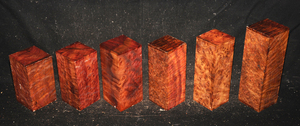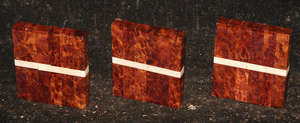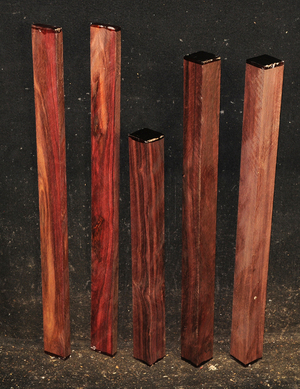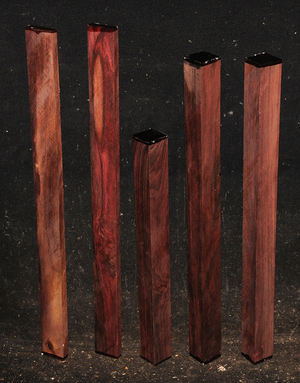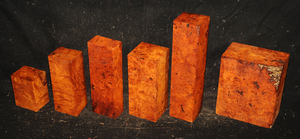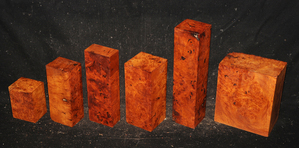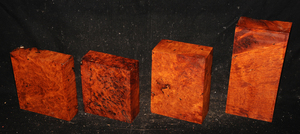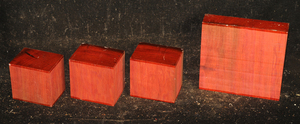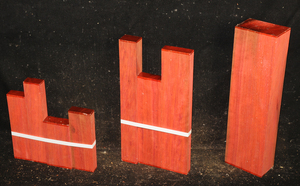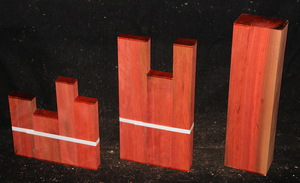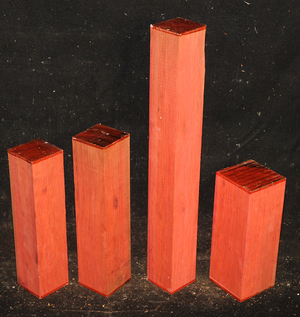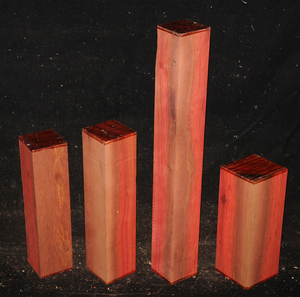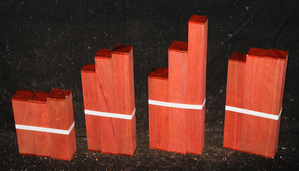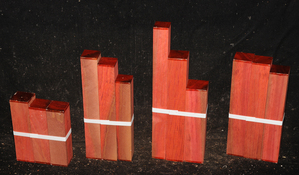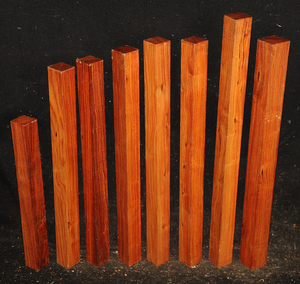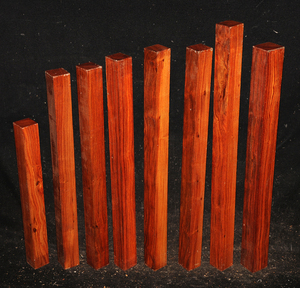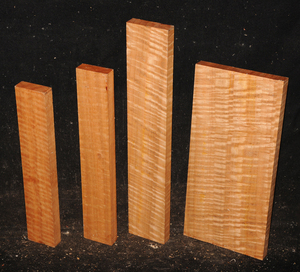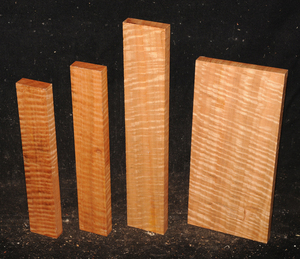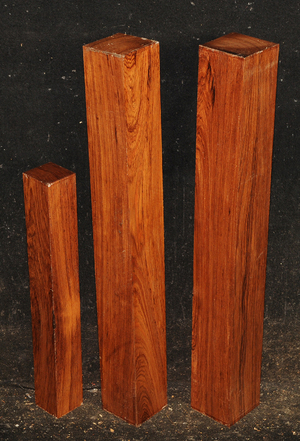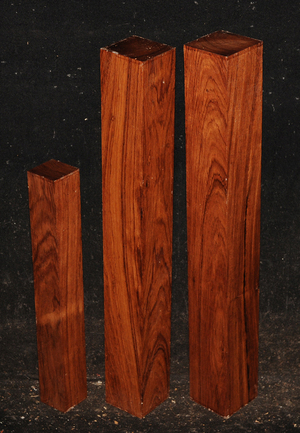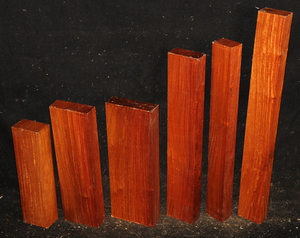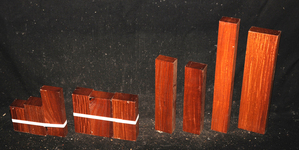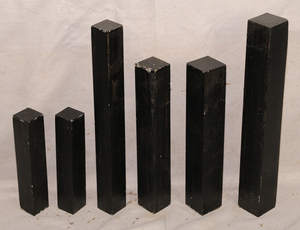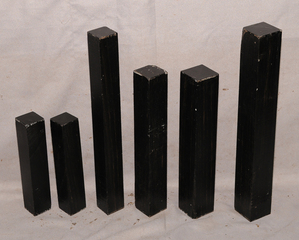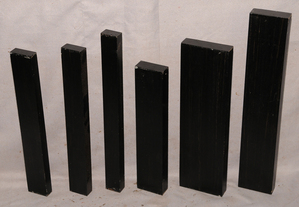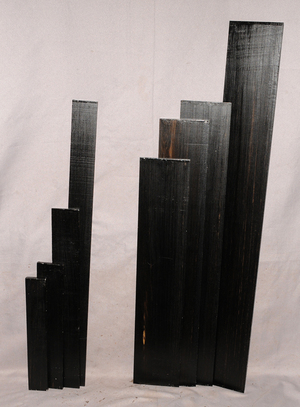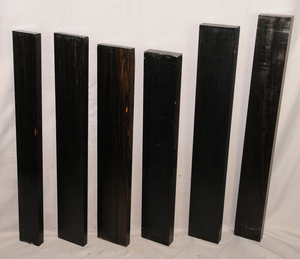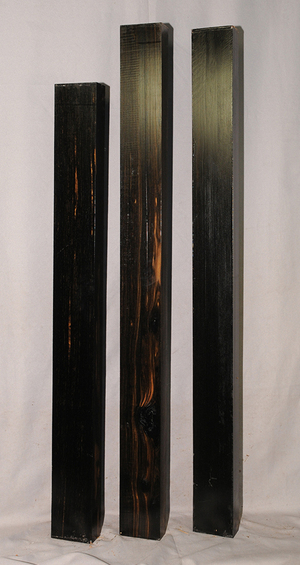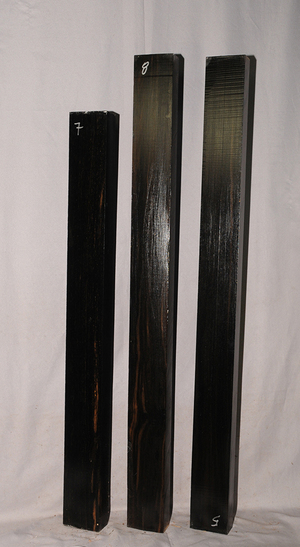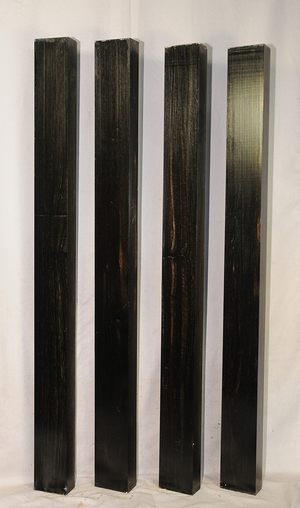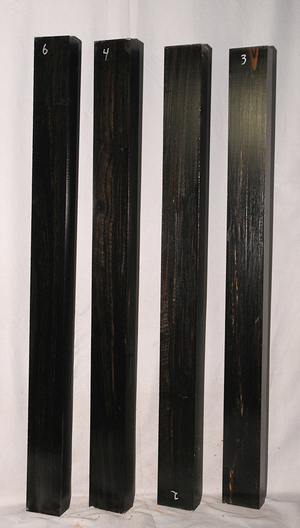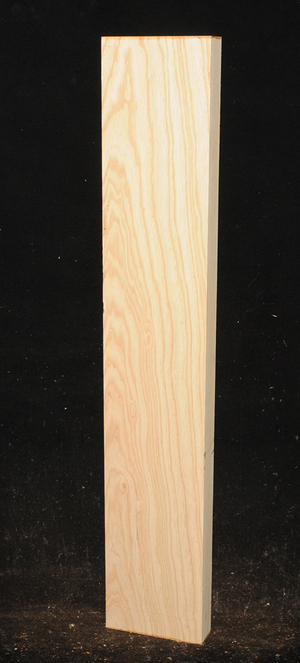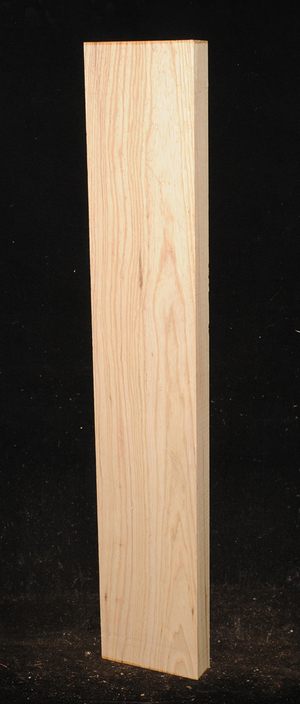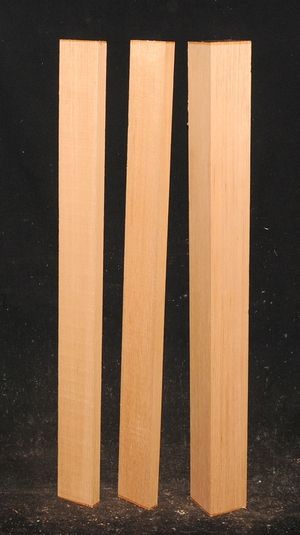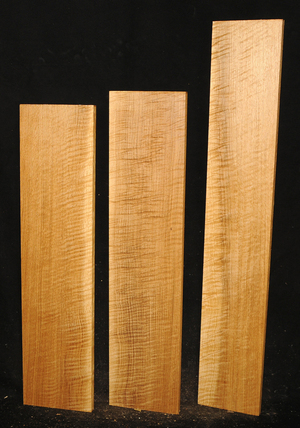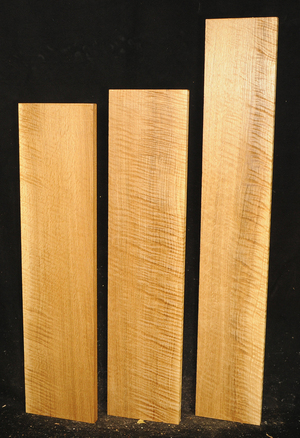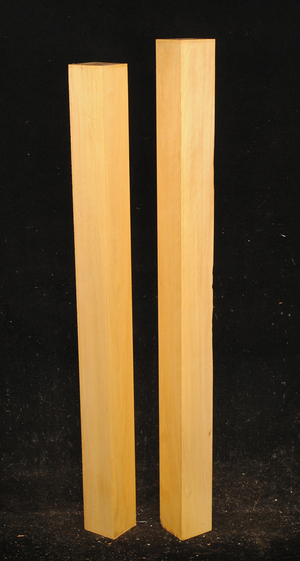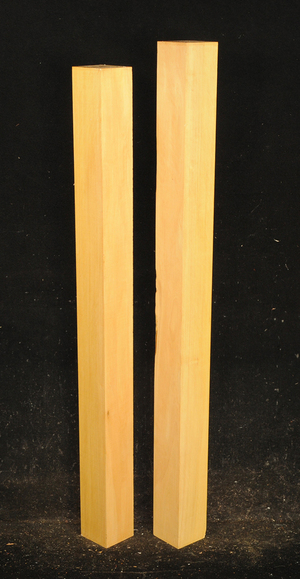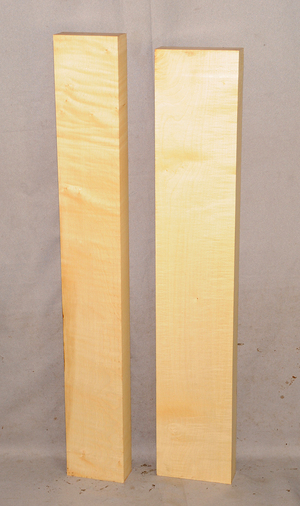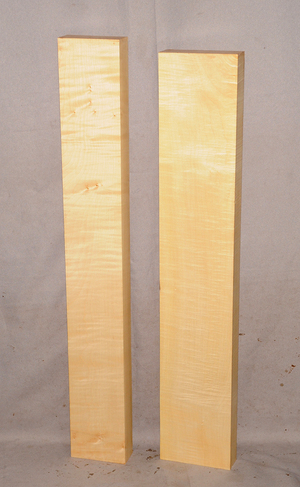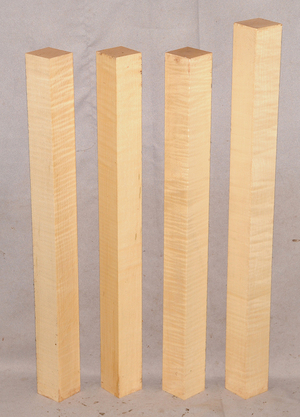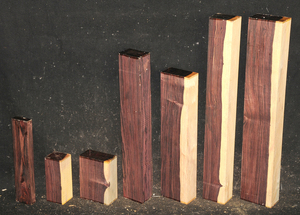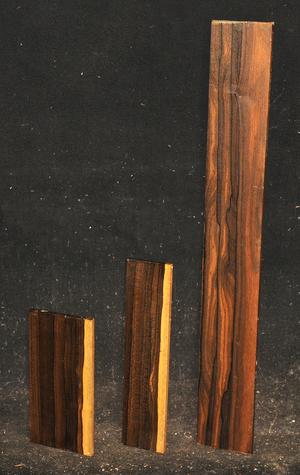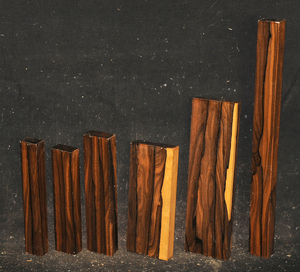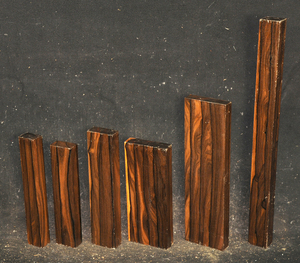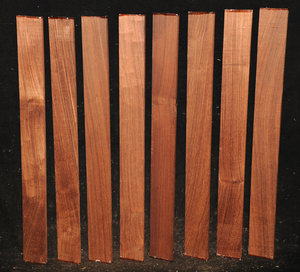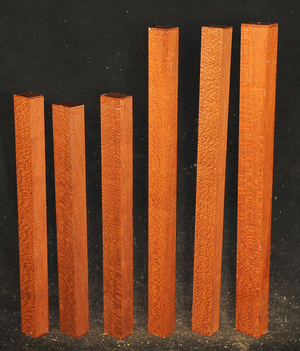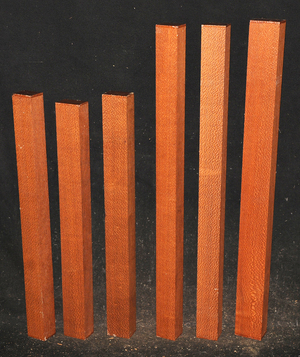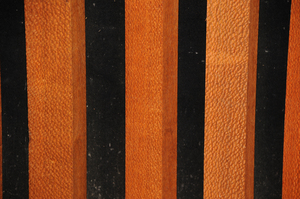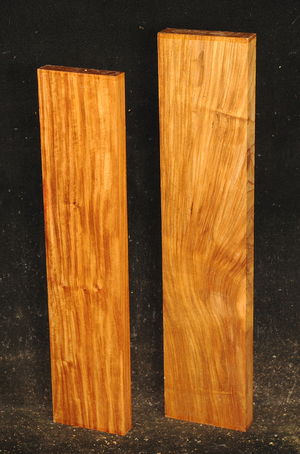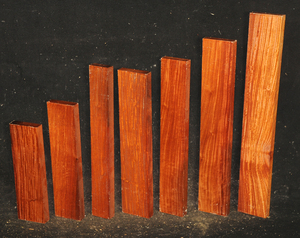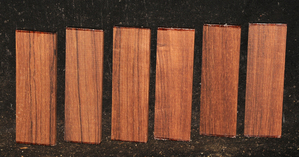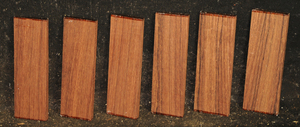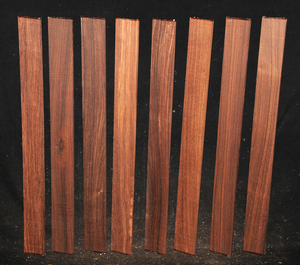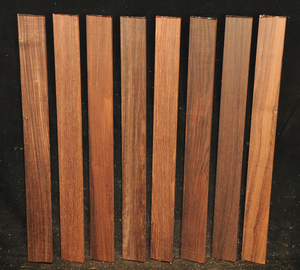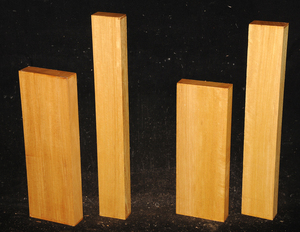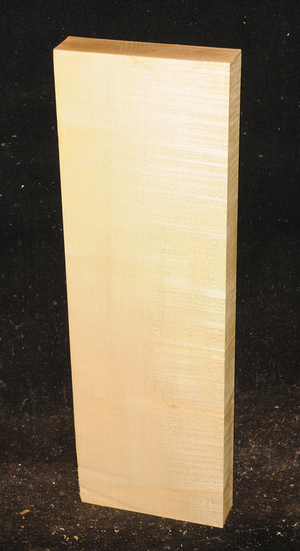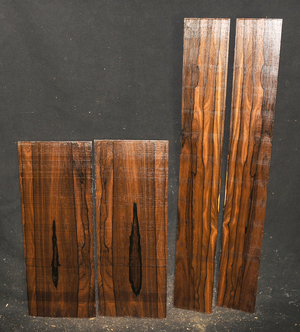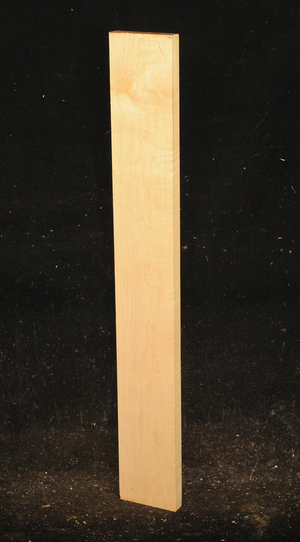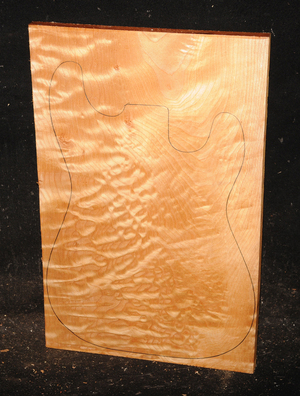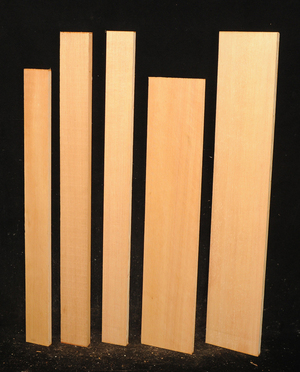Camphor Burl Turning Squares
Cinnamomum sp.
This rare burl is from S.E. Asia and is seldom seen on the world market. It is fine-grained and varies in color from a light reddish-brown to almost scarlet. It is easy to work and has a very pungent, spicy scent. For a burl it is remarkably stable. Green to partially air dried.
Item Number: W43771
Camphor Burl
Cinnamomum sp.
This rare burl is from S.E. Asia and is seldom seen on the world market. It is fine-grained and varies in color from a light reddish-brown to almost scarlet. It is easy to work and has a very pungent, spicy scent. For a burl it is remarkably stable. Green to partially air dried.
Item Number: W43770
Camphor Burl Pen Blank Bundles
Cinnamomum sp.
This rare burl is from S.E. Asia and is seldom seen on the world market. It is fine-grained and varies in color from a light reddish-brown to almost scarlet. It is easy to work and has a very pungent, spicy scent. For a burl it is remarkably stable. Green to partially air dried.
6 pieces per bundle.
Item Number: W43768
Bois de Rose
Dalbergia maritima
Bois de Rose is a true rosewood from Madagascar and is little known on the world timber market. It is a deep burgundy color, sometimes with darker striping and darkens on exposure. It is hard and heavy and takes a high, glassy- smooth polish. This wood has a tap tone more like old Brazilian Rosewood than any other species we have cut. Bois de Rose is one of the rarest in the rosewood family. We have a very limited stock of this beautiful wood and when it is gone we will not be able to replace it. Air dried.
Due to CITES regulations, we can only ship this species to customers in the United States.
Item Number: W43766
Makamong Burl
Afzelia xylocarpa
This is from S.E. Asia and is also called Makamong. We cut a large burl years ago into 4" to 6" slabs. The burl was old to begin with, and had been lying in a timber brokers yard for who knows how long. But it was long enough for pests to burrow through the sapwood and into a bit of the heartwood. The effects were incredible. It reminds me of an old dolomite cave complex after thousands of years of water erosion. Full of fissures and chasms, it is easy to visualize bats flying in and out or maybe a miniature version of Shelob's lair.
Item Number: W43765
Makamong Burl
Afzelia xylocarpa
This is from S.E. Asia and is also called Makamong. We cut a large burl years ago into 4" to 6" slabs. The burl was old to begin with, and had been lying in a timber brokers yard for who knows how long. But it was long enough for pests to burrow through the sapwood and into a bit of the heartwood. The effects were incredible. It reminds me of an old dolomite cave complex after thousands of years of water erosion. Full of fissures and chasms, it is easy to visualize bats flying in and out or maybe a miniature version of Shelob's lair.
Item Number: W43764
Chakte-kok Bowl Blanks
Cosmocalyx spectabilis
This species is from the Yucatan Peninsula of Mexico. It is also called Redheart. Freshly cut it is a brilliant red color which darkens on exposure.
Item Number: W43763
Chakte-kok Bundles & Block
Cosmocalyx spectabilis
This species is from the Yucatan Peninsula of Mexico. It is also called Redheart. Freshly cut it is a brilliant red color which darkens on exposure.
A has 4 pieces.
B has 3 pieces.
Item Number: W43762
Chakte-kok Turning Squares
Cosmocalyx spectabilis
This species is from the Yucatan Peninsula of Mexico. It is also called Redheart. Freshly cut it is a brilliant red color which darkens on exposure.
Item Number: W43761
Chakte-kok Turning Square Bundles
Cosmocalyx spectabilis
This species is from the Yucatan Peninsula of Mexico. It is also called Redheart. Freshly cut it is a brilliant red color which darkens on exposure.
Each bundle has 3 pieces.
Item Number: W43760
Pau Rosa Turning Squares/Pool Cue Blanks
Swartzia fistuloides
Hard & heavy & capable of a beautiful polish. Rare on the American market. Partially air dried.
Item Number: W43759
Figured Eucalyptus
Item Number: W43758
Honduras Rosewood Turning Squares
Dalbergia stevensonii
A true rosewood, most of our stock comes from Belize. Smelling like stored apples, it is a lovely wood to turn and takes a fantastic polish. Getting scarce on the world market.
Due to CITES regulations, we can only ship this species to customers in the United States.
Item Number: W43757
Figured Narra
Pterocarpus indicus
Also called New Guinea Rosewood. It is a beautiful, highly lustrous golden yellow color sometimes with reddish streaks. A nice turning wood it is also used in furniture, jewelry boxes, handles, etc. It is easy to work and glue and takes a nice polish.
Item Number: W43756
Figured Narra Bundles & Blocks
Pterocarpus indicus
Also called New Guinea Rosewood. It is a beautiful, highly lustrous golden yellow color sometimes with reddish streaks. A nice turning wood it is also used in furniture, jewelry boxes, handles, etc. It is easy to work and glue and takes a nice polish.
The bundles have 3 pieces each.
Item Number: W43755
West African Ebony Turning Squares Bundles
Diospyros crassiflora
Sometimes called Gabon or Gaboon, this Ebony is sometimes jet black but oftentimes has grayish streaks that mostly disappear when finished or after the made object has been put into service. This Ebony has a marked resistance to checking that is characteristic of some of the Indian and Asian species. It has a wonderful texture and is easily carved, planed, turned, and milled. It is fairly fine-grained and takes a high polish. This Ebony usually originates in either Cameroon or Nigeria and the logs are rough hewn in the forest and oftentimes brought to the nearest road by human porters. With the disappearance of other species of black Ebony this species is fast becoming the Ebony of choice.
Item Number: W43754
West African Ebony
Diospyros crassiflora
Sometimes called Gabon or Gaboon, this Ebony is sometimes jet black but oftentimes has grayish streaks that mostly disappear when finished or after the made object has been put into service. This Ebony has a marked resistance to checking that is characteristic of some of the Indian and Asian species. It has a wonderful texture and is easily carved, planed, turned, and milled. It is fairly fine-grained and takes a high polish. This Ebony usually originates in either Cameroon or Nigeria and the logs are rough hewn in the forest and oftentimes brought to the nearest road by human porters. With the disappearance of other species of black Ebony this species is fast becoming the Ebony of choice.
Item Number: W43753
West African Ebony Thinwood Bundles
Diospyros crassiflora
Sometimes called Gabon or Gaboon, this Ebony is sometimes jet black but oftentimes has grayish streaks that mostly disappear when finished or after the made object has been put into service. This Ebony has a marked resistance to checking that is characteristic of some of the Indian and Asian species. It has a wonderful texture and is easily carved, planed, turned, and milled. It is fairly fine-grained and takes a high polish. This Ebony usually originates in either Cameroon or Nigeria and the logs are rough hewn in the forest and oftentimes brought to the nearest road by human porters. With the disappearance of other species of black Ebony this species is fast becoming the Ebony of choice.
4 pieces in each bundle.
Item Number: W43752
West African Ebony
Diospyros crassiflora
Sometimes called Gabon or Gaboon, this Ebony is sometimes jet black but oftentimes has grayish streaks that mostly disappear when finished or after the made object has been put into service. This Ebony has a marked resistance to checking that is characteristic of some of the Indian and Asian species. It has a wonderful texture and is easily carved, planed, turned, and milled. It is fairly fine-grained and takes a high polish. This Ebony usually originates in either Cameroon or Nigeria and the logs are rough hewn in the forest and oftentimes brought to the nearest road by human porters. With the disappearance of other species of black Ebony this species is fast becoming the Ebony of choice.
D has a few small pinholes on the edge.
Item Number: W43751
Chakte-kok Lam Top Guitar Set
Cosmocalyx spectabilis
This species is from the Yucatan Peninsula of Mexico. It is also called Redheart. Freshly cut it is a brilliant red color which darkens on exposure.
Item Number: IW37231
West African Ebony Guitar Neck Blanks
Diospyros crassiflora
Sometimes called Gabon or Gaboon, this Ebony is sometimes jet black but oftentimes has grayish streaks that mostly disappear when finished or after the made object has been put into service. This Ebony has a marked resistance to checking that is characteristic of some of the Indian and Asian species. It has a wonderful texture and is easily carved, planed, turned, and milled. It is fairly fine-grained and takes a high polish. This Ebony usually originates in either Cameroon or Nigeria and the logs are rough hewn in the forest and oftentimes brought to the nearest road by human porters. With the disappearance of other species of black Ebony this species is fast becoming the Ebony of choice.
Item Number: IW37230
West African Ebony Guitar Neck Blanks
Diospyros crassiflora
Sometimes called Gabon or Gaboon, this Ebony is sometimes jet black but oftentimes has grayish streaks that mostly disappear when finished or after the made object has been put into service. This Ebony has a marked resistance to checking that is characteristic of some of the Indian and Asian species. It has a wonderful texture and is easily carved, planed, turned, and milled. It is fairly fine-grained and takes a high polish. This Ebony usually originates in either Cameroon or Nigeria and the logs are rough hewn in the forest and oftentimes brought to the nearest road by human porters. With the disappearance of other species of black Ebony this species is fast becoming the Ebony of choice.
Item Number: IW37229
Swamp Ash Instrument Billet
Fraxinus profunda
This White Ash comes from the southern U.S.A. and is noteworthy for its very light weight, 2.2-3.2 lbs. per board foot. Used mainly in the musical instrument trade for light weight electric guitars, it also has very nice acoustic properties.
Item Number: IW37228
Spanish Cedar Guitar Neck Blanks
Cedrela sp.
Also called Cigar Box Cedar because of its aromatic scent and its wide use in tobacco humidors. It resembles the wood of South American Mahogany to which it is related. Heartwood color varies from a light pinkish brown to reddish brown. It is fairly light in weight.
Due to CITES regulations, we can only ship this species to customers in the United States.
Item Number: IW37226
Bloodwood
Brosimum paraense
Also called Satine, Cacique, and Cardinalwood. The heartwood is a rich strawberry red, in sharp contrast to the light colored sapwood. Takes a high, lustrous finish.
Item Number: W43750
Vertical Grain Douglas Fir
Pseudotsuga taxifolia
Douglas Fir tends to be stiffer than either Spruce or Cedar.Air-dried.
Item Number: W43748
Curly White Oak
Quercus alba
This Oak is from the Eastern U.S.A. We have units of this beautiful curly Oak in 4/4, 5/4, and 6/4 thicknesses and mostly quartersawn. Please inquire for quantity pricing.
Item Number: W43746
Quilted Big Leaf Maple
Acer macrophyllum
This tree is native to the Pacific Northwest. It has the distinction of having the largest leaf of the Maples-up to 15" in diameter. This is a soft Maple. The tree can produce many different types of figure, including quilted (tubular, popcorn, & cloud), curly (fiddleback, broken, & basketweave), and burl.
Item Number: W43745
Castello Boxwood
Calycophyllum multiflorum
Castello Boxwood, though not a true Buxus species, still has a very fine texture and a lovely light canary yellow color. This is truly a dream wood to mill.It is an excellent turnery wood, capable of very fine detail. Also very popular for making scale timbers and other parts for model ships. Air-dried.
Item Number: W43744
Curly European Sycamore
Acer pseudoplatanus
This European Maple is native to central Europe and west Asia. It is a tough, white or cream colored, fine-grained timber. It reminds me of vanilla ice cream because it is so even-colored. It works well in any grain direction. It is used for musical instruments, furniture, cabinetry, and because it is non-staining it is used for kitchen utensils, wooden spoons, rolling pins, and cutting boards. The figure is fiddleback on the quartersawn surface and more of a broken curl on the flatsawn surface. Select, quartersawn material is used for violin backs and sides and necks. Dry.
Item Number: W43742
Curly European Sycamore Turning Squares
Acer pseudoplatanus
This European Maple is native to central Europe and west Asia. It is a tough, white or cream colored, fine-grained timber. It reminds me of vanilla ice cream because it is so even-colored. It works well in any grain direction. It is used for musical instruments, furniture, cabinetry, and because it is non-staining it is used for kitchen utensils, wooden spoons, rolling pins, and cutting boards. The figure is fiddleback on the quartersawn surface and more of a broken curl on the flatsawn surface. Select, quartersawn material is used for violin backs and sides and necks. Dry.
Item Number: W43741
Curly European Sycamore Turning Squares
Acer pseudoplatanus
This European Maple is native to central Europe and west Asia. It is a tough, white or cream colored, fine-grained timber. It reminds me of vanilla ice cream because it is so even-colored. It works well in any grain direction. It is used for musical instruments, furniture, cabinetry, and because it is non-staining it is used for kitchen utensils, wooden spoons, rolling pins, and cutting boards. The figure is fiddleback on the quartersawn surface and more of a broken curl on the flatsawn surface. Select, quartersawn material is used for violin backs and sides and necks. Dry.
Item Number: W43740
Camatillo
Dalbergia congestiflora
Also called Para Kingwood & Mexican Kingwood. The deep purple heartwood is oily and takes an incredible polish with a smoothness pleasing to the fingertips.
Due to CITES regulations, we can only ship this species to customers in the United States.
Item Number: W43739
Ziricote Thins
Cordia dodecandra
Ziricote is another timber we get from the Yucatan Peninsula of Mexico. It is a lovely wood with a very pronounced ray fleck on radial surfaces sometimes producing a "landscape" effect much like picture jasper.
Item Number: W43738
Ziricote
Cordia dodecandra
Ziricote is another timber we get from the Yucatan Peninsula of Mexico. It is a lovely wood with a very pronounced ray fleck on radial surfaces sometimes producing a "landscape" effect much like picture jasper.
Item Number: W43737
Amazon Rosewood Thins
Dalbergia spruceana
This is a fairly rare species from the Amazon region of Brazil. The heartwood varies from a golden-brown to a reddish-brown often with narrow, dark stripes. It is hard and heavy, but easy to work, and takes a high polish.
Due to CITES regulations, we can only ship this species to customers in the United States.
Item Number: W43736
Amazon Rosewood Thins
Dalbergia spruceana
This is a fairly rare species from the Amazon region of Brazil. The heartwood varies from a golden-brown to a reddish-brown often with narrow, dark stripes. It is hard and heavy, but easy to work, and takes a high polish.
Due to CITES regulations, we can only ship this species to customers in the United States.
Item Number: W43735
Fishtail Oak
Neorites kevedianus
Similar to Brazilian Lacewood but a bit denser with a darker reddish-brown color. Beautiful, lustrous grain with big, silvery medullary rays on the quartersawn face. This species comes from Australia.
Item Number: W43734
Figured Narra
Pterocarpus indicus
Also called New Guinea Rosewood. It is a beautiful, highly lustrous golden yellow color sometimes with reddish streaks. A nice turning wood it is also used in furniture, jewelry boxes, handles, etc. It is easy to work and glue and takes a nice polish.
Item Number: W43733
Figured Narra
Pterocarpus indicus
Also called New Guinea Rosewood. It is a beautiful, highly lustrous golden yellow color sometimes with reddish streaks. A nice turning wood it is also used in furniture, jewelry boxes, handles, etc. It is easy to work and glue and takes a nice polish.
Item Number: W43732
Amazon Rosewood Guitar Bridge Blanks
Dalbergia spruceana
This is a fairly rare species from the Amazon region of Brazil. The heartwood varies from a golden-brown to a reddish-brown often with narrow, dark stripes. It is hard and heavy, but easy to work, and takes a high polish.
Due to CITES regulations, we can only ship this species to customers in the United States.
Item Number: IW37225
Amazon Rosewood Guitar Bridge Blanks
Dalbergia spruceana
This is a fairly rare species from the Amazon region of Brazil. The heartwood varies from a golden-brown to a reddish-brown often with narrow, dark stripes. It is hard and heavy, but easy to work, and takes a high polish.
Due to CITES regulations, we can only ship this species to customers in the United States.
Item Number: IW37224
Amazon Rosewood Guitar Finger Boards
Dalbergia spruceana
This is a fairly rare species from the Amazon region of Brazil. The heartwood varies from a golden-brown to a reddish-brown often with narrow, dark stripes. It is hard and heavy, but easy to work, and takes a high polish.
Due to CITES regulations, we can only ship this species to customers in the United States.
Item Number: IW37223
Amazon Rosewood Guitar Finger Boards
Dalbergia spruceana
This is a fairly rare species from the Amazon region of Brazil. The heartwood varies from a golden-brown to a reddish-brown often with narrow, dark stripes. It is hard and heavy, but easy to work, and takes a high polish.
Due to CITES regulations, we can only ship this species to customers in the United States.
Item Number: IW37222
Movingui Ukulele Back & Sides Billets Sets
Distemonanthus benthamianus
Also called African Satinwood. Generally golden-yellow in color with a very lustrous appearance. Movingui has nice tonal characteristics-bright and "pingy".
Item Number: IW37221
Figured European Sycamore Instrument Billet
Acer pseudoplatanus
This European Maple is native to central Europe and west Asia. It is a tough, white or cream colored, fine-grained timber. It reminds me of vanilla ice cream because it is so even-colored. It works well in any grain direction. It is used for musical instruments, furniture, cabinetry, and because it is non-staining it is used for kitchen utensils, wooden spoons, rolling pins, and cutting boards. The figure is fiddleback on the quartersawn surface and more of a broken curl on the flatsawn surface. Select, quartersawn material is used for violin backs and sides and necks. Dry.
Quartersawn.
Item Number: IW37220
Ziricote Acoustic Guitar Back & Sides Set
Cordia dodecandra
Ziricote is another timber we get from the Yucatan Peninsula of Mexico. It is a lovely wood with a very pronounced ray fleck on radial surfaces sometimes producing a "landscape" effect much like picture jasper.
Item Number: IW37219
Lightly Figured Hard Maple Guitar Neck Blank
Acer saccharum
The heartwood is white or cream to light brown or reddish brown. Because of the generally small size of available logs, most sawmills produce flatsawn boards which will show a broken curl on the surface and a fiddleback curl on the quartersawn edge. Hard and heavy, 45 lbs/cu ft. Easy to work and takes a smooth polish. U.S.A.
Item Number: IW37218
Quilted Big Leaf Maple Carve Top Guitar Blank
Acer macrophyllum
This tree is native to the Pacific Northwest. It has the distinction of having the largest leaf of the Maples-up to 15" in diameter. This is a soft Maple. The tree can produce many different types of figure, including quilted (tubular, popcorn, & cloud), curly (fiddleback, broken, & basketweave), and burl.
Item Number: IW37217
Vertical Grain Douglas Fir
Pseudotsuga taxifolia
Douglas Fir tends to be stiffer than either Spruce or Cedar.Air-dried.
Item Number: W43747

